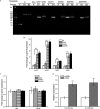Differential Effects of Homologous Transcriptional Regulators NicR2A, NicR2B1, and NicR2B2 and Endogenous Ectopic Strong Promoters on Nicotine Metabolism in Pseudomonas sp. Strain JY-Q
- PMID: 33187996
- PMCID: PMC7848913
- DOI: 10.1128/AEM.02457-20
Differential Effects of Homologous Transcriptional Regulators NicR2A, NicR2B1, and NicR2B2 and Endogenous Ectopic Strong Promoters on Nicotine Metabolism in Pseudomonas sp. Strain JY-Q
Abstract
Nicotine is a toxic environmental pollutant that widely exists in tobacco wastes. As a natural nicotine-degrading strain, Pseudomonas sp. strain JY-Q still has difficulties degrading high concentrations of nicotine. In this study, we investigated the effect of two homologous transcriptional regulators and endogenous ectopic strong promoters on the efficiency of nicotine degradation. Comparative genomics analysis showed that two homologous transcriptional regulators, namely, NicR2A and NicR2Bs (NicR2B1 plus NicR2B2), can repress nicotine degradation gene expression. When both nicR2A and nicR2Bs were deleted, the resulting mutant JY-Q ΔnicR2A ΔnicR2B1 ΔnicR2B2 (QΔABs) exhibits a 17% higher nicotine degradation efficiency than wild-type JY-Q. Transcriptome sequencing (RNA-seq) analysis showed that the transcription levels (fragments per kilobase per million [FPKM] value) of six genes were higher than those of the other genes in JY-Q. Based on the genetic organization of these genes, three putative promoters, PRS28250 , PRS09985 , and PRS24685 , were identified. Their promoter activities were evaluated by comparing their expression levels using reverse transcriptase quantitative PCR (RT-qPCR). We found that the transcription levels of RS28250, RS09985, and RS24685 were respectively 16.8, 2.6, and 1.6 times higher than that of hspB2, encoding 6-hydroxy-3-succinylpyridine hydroxylase, which is involved in nicotine degradation. Thus, two strong endogenous promoters, namely, PRS28250 and PRS09985 , were selected to replace the original promoters of nic2 gene clusters. The effect of the endogenous ectopic promoter was also related to the position of target gene clusters. When the promoter PRS28250 replaced the promoter of hspB2, the resultant mutant QΔABs-ΔPhspB2 ::PRS28250 exhibited nicotine-degrading efficiency 69% higher than that of JY-Q. This research suggests a feasible strategy to enhance strains' capacity for nicotine degradation by removal of repressing regulatory proteins and replacing the target promoter with strong endogenous ectopic promoters.IMPORTANCE This study evaluated the differential effects of homologous NicR2A and NicR2Bs and endogenous ectopic strong promoters on nicotine metabolism in Pseudomonas sp. strain JY-Q. Based on our differential analysis, a feasible strategy is presented to modify wild-type (WT) strain JY-Q by removing repressing regulatory proteins NicR2A and NicR2Bs and replacing the target promoter with strong endogenous ectopic promoters. The resulting mutants exhibited high tolerance and degradation of nicotine. These findings should be beneficial for improving the pollutant-degrading capacity of natural strains through genomic modification.
Keywords: Pseudomonas; endogenous promoter; nicotine degradation; transcriptional repressors.
Copyright © 2021 American Society for Microbiology.
Figures






References
Publication types
MeSH terms
Substances
LinkOut - more resources
Full Text Sources
Other Literature Sources
Research Materials

